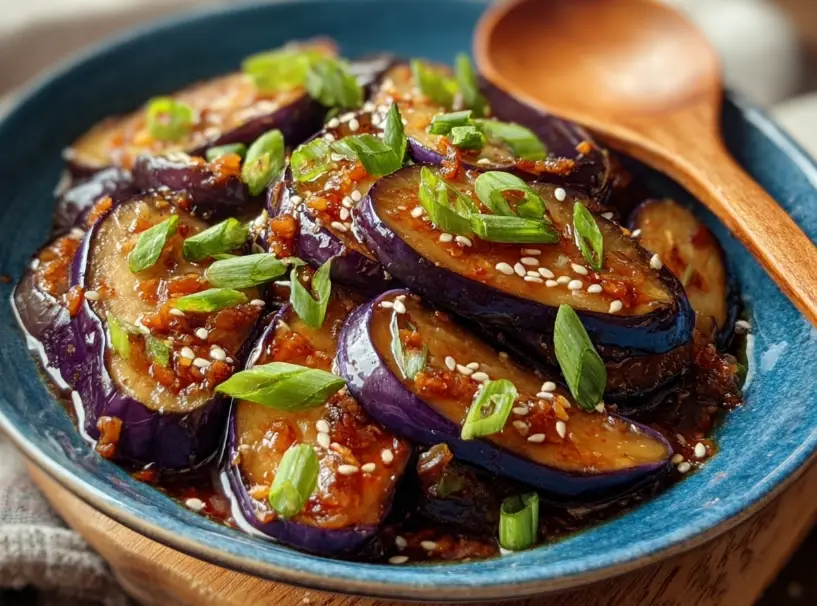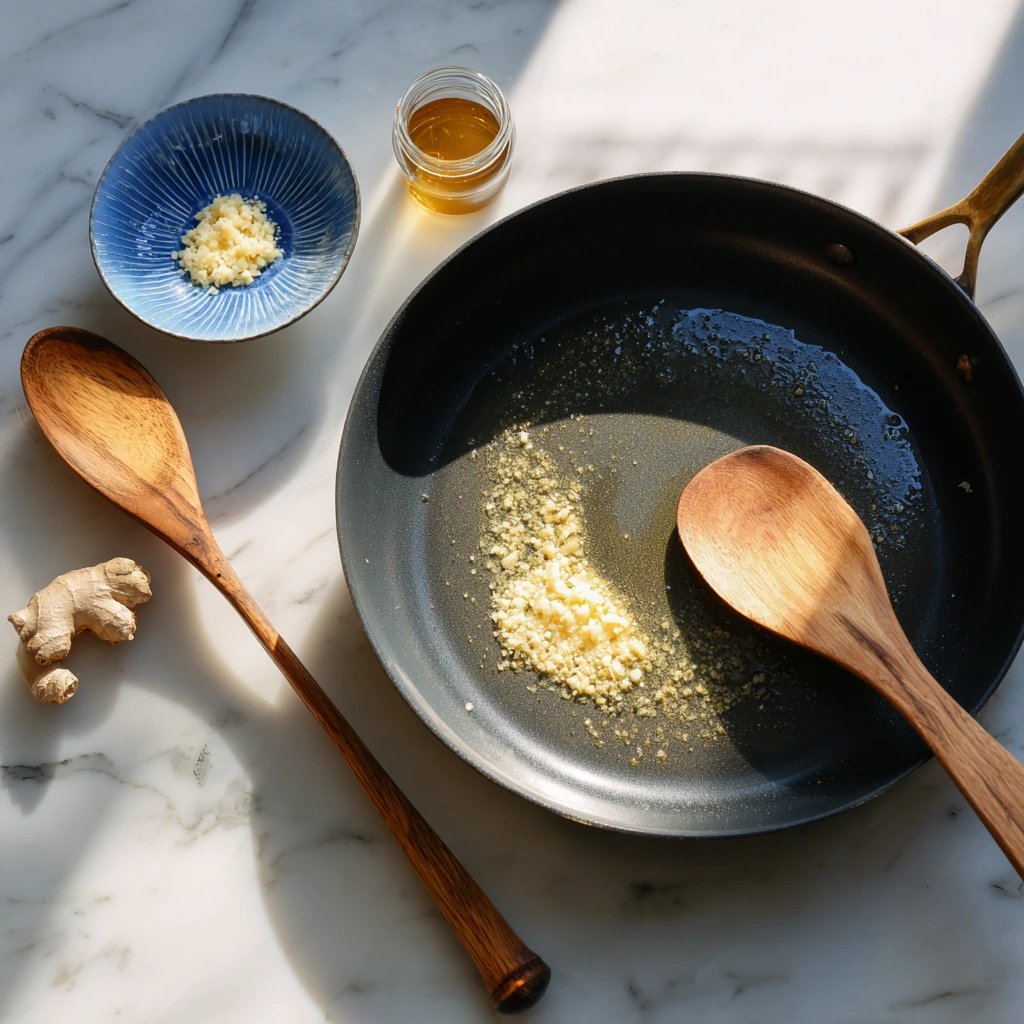There are few dishes I crave more than a warm plate of Chinese Eggplant with Garlic Sauce. It’s that perfect combination of savory, sweet, and slightly tangy — not to mention how the eggplant soaks up all that garlicky goodness like a sponge. If you’ve ever had this dish at your favorite Chinese takeout spot and wondered if you could pull it off at home, I’m here to tell you: you absolutely can.
This recipe is simple enough for a weeknight dinner but flavorful enough to feel special. Whether you’re a long-time eggplant lover or just curious to try something new, this dish might surprise you with how satisfying and deeply comforting it is. It’s become a regular in my own kitchen, especially when I need something hearty, meatless, and fast.
The magic here is all about balance: silky-soft eggplant, bold aromatics like garlic and ginger, and a sauce that hits just the right notes of salty, sweet, and tangy. Pair it with some fluffy steamed rice, and you’ve got a restaurant-quality meal on the table in about 30 minutes.
Let’s jump into this garlicky masterpiece step by step — trust me, you’ll want to keep this one in your dinner rotation.
Ingredients You’ll Need:
3 Chinese eggplants, cut into bite-sized pieces
2 tablespoons vegetable oil
4 garlic cloves, minced
1 tablespoon ginger, minced
1 tablespoon soy sauce
1 tablespoon dark soy sauce
1 tablespoon rice vinegar
1 tablespoon sugar
½ tablespoon cornstarch
½ cup water
1 teaspoon sesame oil
Green onions and sesame seeds for garnish (optional)
Before we get into the cooking, let’s talk eggplants. Chinese eggplants are long and slender with a delicate skin and mild flavor — perfect for soaking up sauce. If you can’t find them at your local market, you can sub in regular globe eggplants. Just be sure to salt them beforehand to tame any bitterness.
STEP 1: Soak the Eggplant to Reduce Bitterness
This little step is optional, but highly recommended if you want that soft, mellow flavor. Slice your eggplants into bite-sized chunks and soak them in salted water for 10–15 minutes. This helps draw out excess moisture and any bitterness — especially useful if you’re using standard eggplants.
Once they’ve soaked, drain and pat them dry really well. Moisture is the enemy of good browning, so take your time here. A dry eggplant will give you that beautiful golden sear we’re going for.
STEP 2: Sear the Eggplant Until Soft and Golden
Heat 2 tablespoons of vegetable oil in a large skillet or wok over medium-high heat. When it’s hot, toss in your eggplant pieces. Let them cook undisturbed for a minute or two to get a nice sear, then stir-fry for about 6–8 minutes total. You’re looking for tender eggplant with browned edges that smell absolutely incredible.
Once cooked, transfer the eggplant to a plate and set aside. We’ll bring it back later when it’s time to soak up all that delicious sauce.
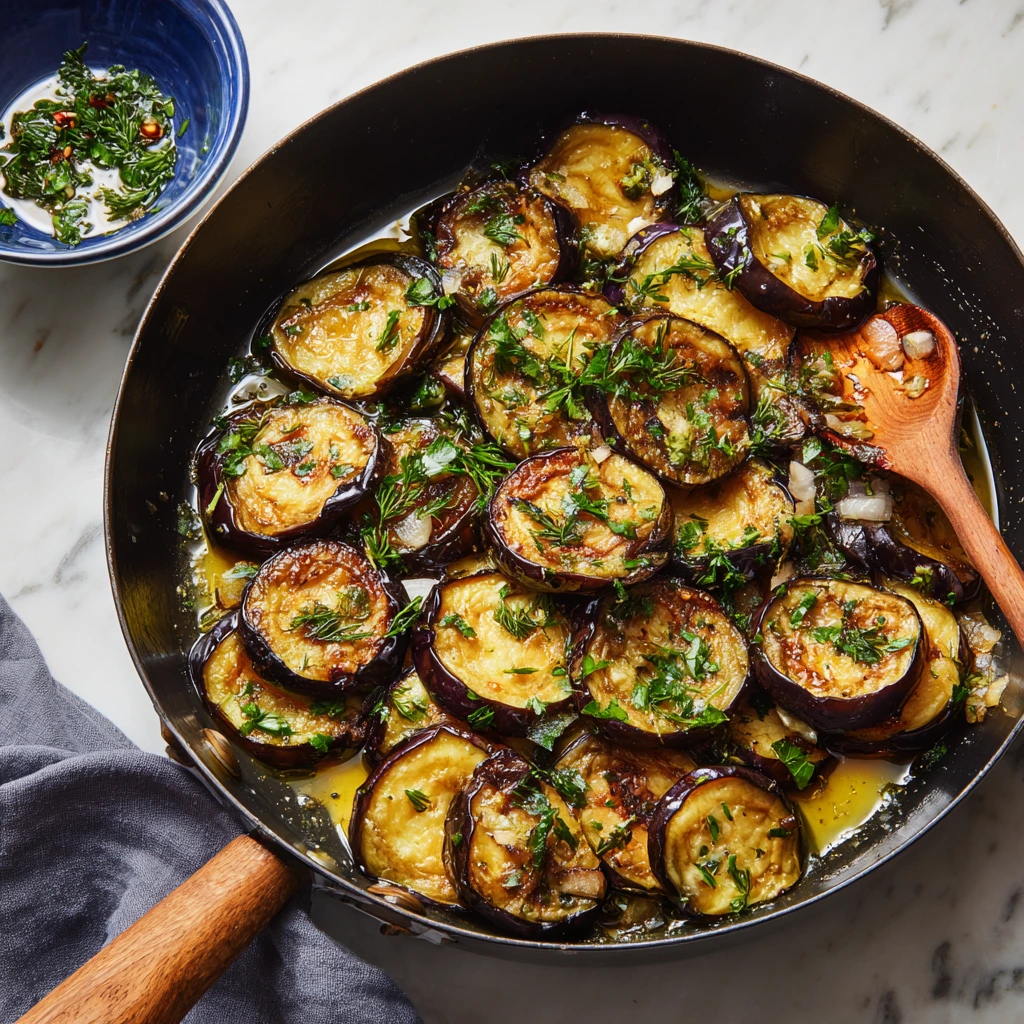
STEP 3: Sauté the Garlic and Ginger
In the same pan (no need to wash it — we want to keep all those flavors), add a touch more oil if the pan looks dry. Toss in your minced garlic and ginger, and sauté for just about 30 seconds. Keep the heat on medium so they don’t burn. You’re looking for that fragrant moment when the garlic and ginger start to release all their aroma — it’s the flavor base of the entire dish.
How to Make Chinese Eggplant with Garlic Sauce
Now that we’ve got our tender eggplant seared and our kitchen smelling like garlic heaven, it’s time to finish strong with that flavorful sauce. This part of the recipe comes together quickly, so be sure to have all your ingredients prepped and ready. You’ll be surprised how much flavor you can pack into one pan in just a few minutes.
I love how the sauce in this dish is both simple and bold. A little soy sauce for saltiness, dark soy sauce for depth and color, rice vinegar to cut through the richness, and just the right touch of sugar to round it all out. The cornstarch brings it all together into a glossy coating that clings beautifully to every piece of eggplant.
Let’s pick up right where we left off.
STEP 4: Make the Garlic Sauce
Grab a small bowl and whisk together the following:
1 tablespoon soy sauce
1 tablespoon dark soy sauce
1 tablespoon rice vinegar
1 tablespoon sugar
½ tablespoon cornstarch
½ cup water
Stir until the sugar and cornstarch dissolve completely. You want this mixture to be smooth and lump-free. The cornstarch is what will thicken the sauce, giving it that velvety texture that coats the eggplant so well.
Quick tip: If you like a spicier version, this is a great moment to toss in a dash of chili garlic sauce or a pinch of red pepper flakes into your sauce mix. It adds a little heat that pairs perfectly with the sweetness and garlic.
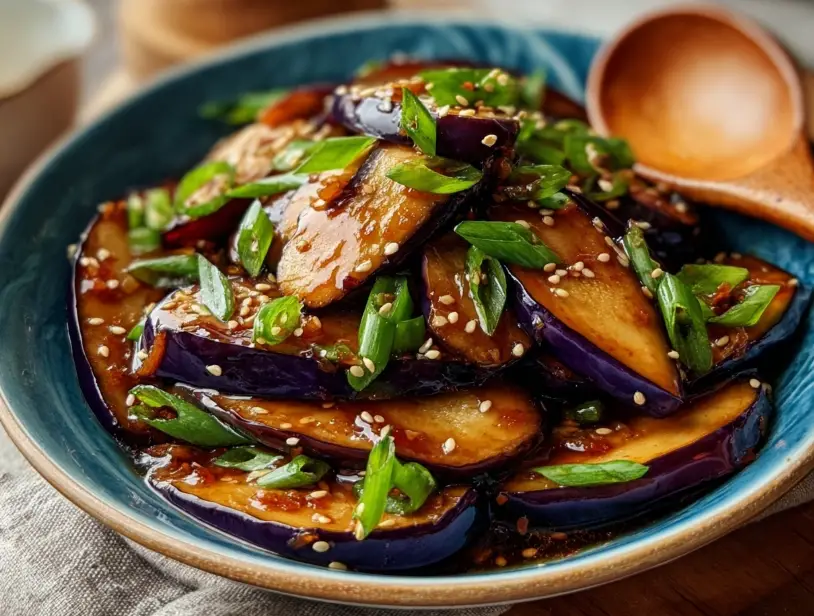
STEP 5: Pour in the Sauce and Simmer
Now pour the sauce mixture into your skillet with the sautéed garlic and ginger. Bring it to a gentle simmer over medium heat, stirring frequently. Within about a minute, you’ll notice it starting to thicken — that’s your cue to bring the eggplant back in.
Add the cooked eggplant pieces back to the pan and toss to coat. Cook everything together for another 2–3 minutes, just until the sauce thickens fully and starts to cling to the eggplant like a glaze. Every piece should be glossy and well-coated.
It’s a good idea to stir gently here — eggplant is delicate once cooked and you want to keep those nice bite-sized pieces intact.
STEP 6: Finish with Sesame Oil and Garnish
Once your sauce has thickened and the eggplant is fully coated, turn off the heat and drizzle in 1 teaspoon of sesame oil. This adds a rich, nutty aroma that elevates the entire dish.
Garnish with thinly sliced green onions and a sprinkle of sesame seeds if you like. These aren’t strictly necessary, but they add a lovely fresh crunch and make the dish look even more inviting when served.
Serving Suggestions and Quick Tips
Best served hot: This dish is at its absolute best when served hot, straight from the skillet. The sauce is thick and glossy, and the eggplant is perfectly tender.
Pair it with rice: Steamed jasmine or white rice is the go-to pairing here. The rice soaks up all the garlicky, savory sauce and turns this into a truly satisfying meal.
Make it a meal: While Chinese Eggplant with Garlic Sauce is often served as a side, you can absolutely serve it as a main dish. For extra protein, consider tossing in some sautéed tofu or mushrooms. The sauce plays well with both.
Leftovers: This dish reheats nicely, though the eggplant will get even softer after refrigeration. Store leftovers in an airtight container in the fridge for up to 3 days. A quick reheat in the microwave or skillet will bring it right back to life.
Ingredient swap: Can’t find Chinese eggplant? Use regular eggplant, just be sure to salt it and soak it in water to remove bitterness. You may also need to peel it if the skin is too tough.
Chinese Eggplant with Garlic Sauce: FAQs and Final Thoughts
Before we wrap things up, let’s go over a few of the most common questions I’ve received (and asked myself) when making Chinese Eggplant with Garlic Sauce at home. If you’re new to cooking eggplant or just want to make sure you get everything right, these quick FAQs should help clear things up.
Frequently Asked Questions
1. Can I use regular eggplant instead of Chinese eggplant?
Yes, you absolutely can. While Chinese eggplants are preferred for their tender skin and milder flavor, regular globe eggplants work too. Just peel the skin if it’s tough and be sure to soak the pieces in salted water for at least 15 minutes to reduce bitterness.
2. How do I prevent the eggplant from getting too oily?
Eggplant acts like a sponge and can absorb a lot of oil. To reduce oil absorption, make sure the pieces are completely dry before frying, and don’t overcrowd the pan. A quick sear over medium-high heat helps create a nice crust without soaking up too much oil.
3. Can I make this recipe gluten-free?
Yes! Just swap the soy sauces for gluten-free tamari or coconut aminos. Everything else in the recipe should already be gluten-free, but always double-check your ingredients, especially the soy sauces.
4. What’s the best substitute for dark soy sauce?
If you don’t have dark soy sauce, you can use regular soy sauce with a splash of molasses or a pinch of brown sugar to mimic the color and depth of flavor. It’s not an exact match, but it gets pretty close.
5. Is this dish vegan?
Yes, it is naturally vegan. There are no animal products in the recipe, so it’s perfect for plant-based eaters. Just make sure any add-ins or garnishes are also vegan-friendly.
6. Can I add protein to this dish?
Definitely. Tofu is a fantastic addition — try pan-frying firm tofu cubes and mixing them in with the eggplant during the final step. You could also add mushrooms for a meaty texture, or serve it as a side dish alongside grilled chicken or shrimp if you’re not strictly vegetarian.
7. Can I make it in advance?
This dish is best when served fresh, but leftovers do hold up pretty well. The eggplant will soften a bit more as it sits, but the flavor remains delicious. Just reheat in a skillet over low heat or pop it in the microwave for a quick meal the next day.
Final Thoughts: Why You’ll Love This Recipe Again and Again
Chinese Eggplant with Garlic Sauce is one of those recipes that really surprises people the first time they try it. It’s simple, meatless, and relies on a few humble pantry ingredients — yet it’s packed with rich, bold flavor. The eggplant becomes melt-in-your-mouth tender, and the sauce? It’s the kind of garlicky, glossy goodness you’ll be licking off your plate.
What I love most is how fast and flexible this recipe is. Whether you’re making a quick weeknight dinner or planning a cozy meal with friends, it’s easy to prepare and always delivers. Plus, it’s completely plant-based and can be adjusted to suit different dietary needs without losing any flavor.
So if you’re looking for something new to add to your dinner rotation, give this dish a try. It’s cozy, satisfying, and might just become your new favorite way to cook eggplant.
Print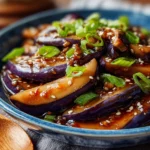
Chinese Eggplant with Garlic Sauce
- Author: Andrew Recipes
Description
Chinese Eggplant with Garlic Sauce is a savory and slightly sweet stir-fry that features tender, melt-in-your-mouth eggplant coated in a bold, garlicky sauce. This popular Chinese takeout-style dish is quick to prepare and best served with steamed rice to soak up every bit of the delicious sauce.
Ingredients
3 Chinese eggplants, cut into bite-sized pieces
2 tablespoons vegetable oil
4 garlic cloves, minced
1 tablespoon ginger, minced
1 tablespoon soy sauce
1 tablespoon dark soy sauce
1 tablespoon rice vinegar
1 tablespoon sugar
½ tablespoon cornstarch
½ cup water
1 teaspoon sesame oil
Green onions and sesame seeds for garnish (optional)
Instructions
Soak the eggplant pieces in salted water for 10-15 minutes to reduce bitterness. Drain and pat dry thoroughly.
Heat oil in a large skillet or wok over medium-high heat. Add the eggplant and stir-fry for 6-8 minutes until browned and softened. Remove and set aside.
In the same pan, add a touch more oil if needed. Sauté the garlic and ginger for 30 seconds until fragrant.
In a small bowl, whisk together soy sauce, dark soy sauce, rice vinegar, sugar, cornstarch, and water until smooth.
Pour the sauce into the pan and bring to a simmer. Return the eggplant to the pan and stir to coat. Cook for 2-3 more minutes until the sauce thickens and clings to the eggplant.
Drizzle with sesame oil and toss gently. Serve hot, garnished with green onions and sesame seeds if desired.
Notes
Chinese eggplants are preferred for their tender skin and mild flavor, but regular eggplants can be substituted if needed. Adjust the sugar and vinegar for your preferred balance of sweet and tangy. This dish is excellent as a vegetarian main or a flavorful side.
